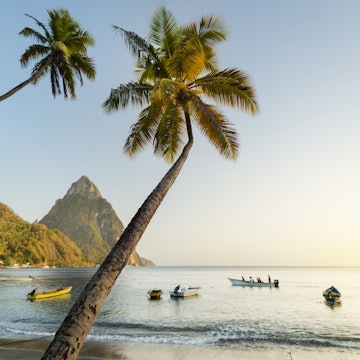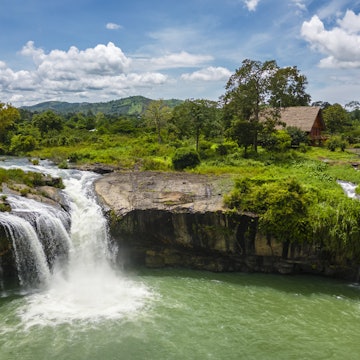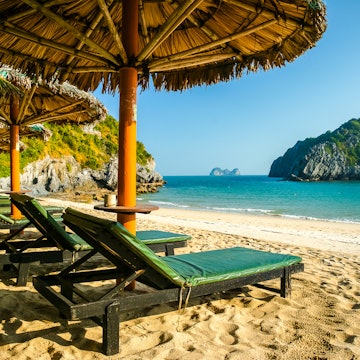

The National Museum of Cambodia. Nalidsa/Shutterstock
Frantic and chaotic at first glance, the soul of Phnom Penh is in fact rich, warm and charming. And in the shadows of glitzy new skyscrapers, pockets of Cambodia's capital still mimic village life.
With few blue chip tourist attractions, the city is often looked over as a stepping stone between Siem Reap and Cambodia’s idyllic southern islands. But that’s a mistake.
Beneath the surface hums a city of contrasts: monks on smartphones, tuk-tuks dodging Lambhorginis, rooftop cocktail bars overlooking street-corner noodle stalls and jet skis buzzing past old wooden longtails pulling fish out the Mekong River. Stand in one place and be mesmerized for hours. There’s so much to unpack.
Khmer Rouge history, Buddhist monasteries and the Royal Palace make Phnom Penh worth visiting; its buzzing art, food and nightlife scenes make it worth staying.

When should I go to Phnom Penh?
High season is November to March: clear skies, dry days, tourists. Low season has been rebranded “green season,” and fair enough too. Those who dodge the May to October monsoon also miss mother nature dressed in her most glamorous greens.
There’s three annual holidays that stop Cambodia in its tracks – definitely consider them in planning. In April, Khmer New Year is a four-day water fight that’s hard to avoid and loads of fun if you choose to get involved. In November, the city swells with provincial people for the Water Festival (Bon Om Touk), where dragon boats race for three days past riotous riverbanks to a finish line in front of the Royal Palace. Full pomp and ceremony for the bigwigs. Bedlam for the thousands of countryfolk whooping it up on a rare trip to the city. Absolute scenes! Watch a race session from the Chrouy Changva bridge – what a spectacle! In September, though, the opposite happens and Phnom Penh turns into a ghost town for about a week during Pchum Ben, festival of the ancestors, with the majority of residents gone country to visit relatives. Many businesses shut down or run on skeleton staff. Not an ideal time to visit.
How much time should I spend in Phnom Penh?
It would be a shame to come to Phnom Penh for only just a day or two, as you’d likely spend almost the entirety sunk into the misery of Cambodia’s tragic recent history. That’s important to understand – but Cambodia and its young, ambitious population have plenty to show from the more than 45 years since. And to properly take the pulse of modern Cambodia, you’d need to get to know Phnom Penh, at least a bit. So stick around for a third or fourth night – or learn the history, see the sites and then dance, drink, exhibition and eat your way around town for the rest of a week.

Is it easy to get in and around?
Phnom Penh’s new airport is stunning but it’s also the better part of an hour away from the city center on a good day for traffic. Take the bus at the wrong time of day (7–9am; 4–9pm) and you could lose two hours. Private taxi or tuk-tuk is the best option.
When you exit the airport, say “no thank you“ to everyone until you get an offer for $12.50 (50,000 riel) or less to your hotel. Once in the city, almost everything is no more than a 20-minute ride away, and plenty is much closer. Download Grab or PassApp for easy transport around the city or pay a dollar extra for the more comfortable, sustainable remorques – you have to talk to people (yeah, yuck!), but your fare goes direct to a breadwinner’s pocket rather than a company that pays crumbs for labor. Alternatively, plenty of the city is within walking distance – but, aside from the riverside, there’s a distinct lack of footpaths so keep your wits about you (and tuck in your valuables, including your phone: walkers are the main targets for drive-by thieves).

Top things to do in Phnom Penh
Revisit Cambodia’s dark history
Less than 50 years ago, Phnom Penh was a ghost city, its residents sent to hard labor, prison camps or death as the Khmer Rouge wrought inexplicable evil that wiped out a quarter of the population. The Killing Fields (aka Choeng Ek) and Tuol Sleng Genocide Museum (S-21) are the must-sees. It’s tough to confront and the feeling will never leave you – so come prepared.
Take a spin through the art and social scenes
Phnom Penh is the hub for Cambodia’s creative revival. For a dip into the contemporary art scene, check what’s on at R5 Showroom (Romcheik 5), the French Institute and Pteah Chas, then cool off with a drink and see what’s new at Station 350 – an exhibition and hang space for lovers of street art. Or stroll down Street 178, where dozens of artists’ workshops are open houses facing the Royal University of Fine Arts. After dark, head for Oscar’s on the Corner for live music every night of the week – or head to Tuol Tom Pong where you might be able to walk between multiple venues with live shows. If midnight doesn’t stop you, go to the next level in Bassac Lane, where Uniga and Canopy are the elite late night spots, or hit Blue Chili for a raucous drag show.

Tour the top wats
If Phnom Penh has a spiritual circuit, this is it. Start early with blessings at Wat Ounalom – headquarters for Cambodian Buddhism, residence of the Supreme Patriarch and home to a hair that is said to be from the Buddha’s eyebrow. There’s no handling the hair but for a small donation, you can get splashed with holy water and a red string tied around your wrist for good luck. Thirteen years strong and still I go – I’m putting it down to the monks. About a kilometer south along the river, Wat Botum is a leafy sanctuary with huge murals and stupas that hold the ashes of many of the city’s dignitaries. Follow the nature strip about another kilometer, past former Prime Minister Hun Sen’s house and the Independence Monument to Wat Langka, a favorite place of worship for the elites that takes its name from its time as a sacred meeting place for Cambodian and Sri Lankan monks in the 1400s. Bring a book to read or just sit by the pond and ponder. Don’t forget to dress modestly, shoulders covered, and behave respectfully while inside Cambodia’s treasured places of worship.
Step into Cambodia’s royal history
Side by side in the heart of the city, the Royal Palace and National Museum of Cambodia are a graceful reminder that Phnom Penh’s backstory runs much deeper than its tragic recent past. With its gilded spires and perfect garden courtyards, the palace is still the home base of King Sihamoni while also open to the public (parts of it, at least). Next door, the National Museum’s entrance serves as a portal from madness outside into a world of serenity, silent halls and showrooms displaying artifacts that date back as far as the 4th century. The museum’s collection has grown quietly in recent years thanks to the return of stolen treasures. Check out the 2025 film LOOT: A Story of Crime and Redemption to learn about the notorious antiquities trafficker Douglas Latchford.

My favorite thing to do in Phnom Penh
You can spend all day and night exploring the different realms of Phnom Penh. But this one’s really simple – simple to identify and simple to execute. As the heat drifts out of the day, make your way to the riverside, where the full spectrum of Phnom Penh’s elements gather each day. By dark, it’s buzzing – equal parts park, food fair, carnival, dance party, gymnasium and catwalk – the full menagerie of Phnom Penh’s classes and characters out to play with a backdrop of fishing boats and sunset cruises dawdling in shadows on the Mekong. This is seven days a week – and there’s no need for bookings. At the northern end of the esplanade, the “badlands," is streets lined with scantily-clad hostesses calling “handsome men“ into bars. Don’t go there. Instead, head for the southern end. Grab something you like to eat or drink on the way, stop in front of the Royal Palace, find comfort on the nicest grass in Phnom Penh, and watch the world whiz by.
How much money do I need for Phnom Penh?
The cost of living – and holidaying – is rising in Phnom Penh but it remains among the most affordable capitals in Southeast Asia. A daily budget of US$100 would be a good time. You could get by easily on US$50 or skimp for US$20. US dollars and Khmer riel are accepted everywhere. Credit cards much less. The city is saturated with ATMs. Oh, and tip service staff but don’t give money to kids begging on the street – it only ensures that they keep getting put to work.
Night in a lavish boutique hotel: $60
Noodle soup on the street: $2
Ferry across the river: 25 cents
Espresso martini at Eagle Café: $3.50
Handwoven krama from Watthan Artisans: $5
Vinyl record from Cloud: $20
Bag of fried crickets: $2
Tuk-tuk home after a night out: $3
How safe is Phnom Penh?
Travel advisories often mention drive-by bag-snatching as a feature of Phnom Penh. While it does happen, Phnom Penh is actually relatively safe and it’s quite easy to avoid. Bag snatchers look for the softest targets – items that can be easily snatched from someone as they drive past. So tuck your jewelry in (or leave it at home), keep your phone in your pocket or close to your chest if you must have it out, and minimize the exposure of any bags or straps that might look easy for a thief to grab. Unless you look like an easy target, potential thieves won’t bother you. Enjoy!
Matt Blomberg is based in Phnom Penh and contributed to the Lonely Planet Cambodia guidebook that was published in September 2025.














